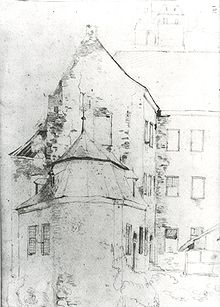Schönrath Castle
| Schönrath Castle | ||
|---|---|---|
|
Schönrath Castle - View from the south of the outer bailey |
||
| Alternative name (s): | huis schonraedt, schoinrait | |
| Creation time : | around 1400 to 1600 | |
| Castle type : | Niederungsburg | |
| Conservation status: | Ruin (main castle) ; Maintaining essential parts (outer bailey) |
|
| Construction: | Quarry stone, half-timbered | |
| Place: | Lohmar | |
| Geographical location | 50 ° 53 '24 " N , 7 ° 12' 53" E | |
| Height: | 140 m above sea level NHN | |
|
|
||
The castle Schönrath is a partial only as ruins existing lowland castle in North Rhine-Westphalia . It belongs to the city of Lohmar and is located in the Rhein-Sieg district .
location
The small castle is located in the gently sloping basin of a brook that flows into the Gammersbach , at an altitude of 140 meters above sea level between the districts of Lohmar-Wickuhl and Rösrath- Rambrücken near the hamlet of Georgshof / Oberschönrath.
history

The former knight's seat was first mentioned in a document in the 13th century, at that time it belonged to the Lords of Schönrode . In the following centuries the castle changed hands several times. It went to various noble families of the von Landsberg , von Nesselrode and von Quadt families until it became the property of the von Plettenberg family in the 15th century . After the death of Wilhelm von Plettenberg , the castle and its lands were divided among the inheriting daughters. In 1563, Diederich von Heyden , Elisabeth von Plettenberg's son , was able to pay off the brothers-in-law and brought the castle into the von Heiden family's possession for a good 100 years .

As the late 17th century, the descendants of the family of Heiden their possessions in Bergisch Land to give up and the Brandenburg turn, is the castle Schonrad on October 4, 1695 along with their Appertinentien (accessory, the associated goods ds) for 30,000 Reichstaler to sold to Freiherr Ernst von Erlenkamp . In connection with this sale, the amount of the income from the nine farms and two water mills belonging to the castle is recorded : 119 Malter rye , 80 Malter oats , 2 Malter barley , 6 calves , 32½ pigs , 1 mutton , 7 feed cattle , 8 sacks of coal , 32 pounds of flax , 100 eggs , 150 chickens , 4 pounds of pepper , 4 pounds of ginger , 6 pounds of sugar , 4 measures of butter , additional services to be performed and cash in the amount of 82 Reichstalers and 256 Stübern .
During the following two centuries, the value of the free aristocratic property decreased considerably as the associated farms were gradually sold to the bourgeoisie . The number of residents at Hof Schönrath is known from the 19th century: 1829 17 people at two fireplaces, 1843 15 residents, 1851 10 residents, 1872 12 people in two houses and two households. The castle itself also passed through several owners at this time until it belonged to the Scharrenbroich family from 1855 to 1925 . The main castle , which was no longer inhabited in the 19th century - the castle chapel is known to have been used until around 1835 - is gradually demolished until the 1920s and blown up in January 1928, the material being used for road construction. The outer bailey is continuously used as an agricultural operation.
The buildings are now privately owned.
investment
The main castle was built on medieval foundations between the 15th and 16th centuries . In the 18th century the outer bailey was renewed, while the main three-storey complex was changed in major parts. This, in the form of an angular castle, is accessible from the west via a brick bridge . The complex also has an octagonal castle chapel and is surrounded by a moat .
Today the outer bailey, which consists of stables and outbuildings in addition to the two-story house , is inhabited by the owners.
There are only small remains of the wall of the main castle that are heavily overgrown. The former moat is almost completely silted up except for a pond. Next to the entrance to the outer bailey is a 300 year old yew tree with an unusual multi-stemmed crown .
The castle complex cannot be visited, but only viewed from the nearby road.
literature
- Rhein-Sieg-Kreis, The District Administrator (Hrsg.): Yearbook of the Rhein-Sieg-Kreis 2007 . Edition Blattwelt, Niederhofen 2006, ISBN 3-936256-24-1 .
- Gernert, Klaus-Dieter and Wolff, Helmut et al. (Hrsg.): Chronicle of the community Rösrath . 2 volumes. Self-published by the history association for the community of Rösrath and surroundings e. V., Rösrath 1993, ISBN 3-922413-35-8 .
- Wilhelm Pape: Settlement and home history of the community Lohmar . Pressure u. Publishing company Helmut Grümer, Lohmar 1983.
- Hennekeuser, Heinrich: RHEINISCHE KUNSTSTÄTTEN, issue 234: Lohmar community . Rhenish Association for Monument Preservation and Landscape Protection (Ed.), Cologne 1980, ISBN 3-88094-328-1 .
Web links
Individual evidence
- ↑ after Rutt, Theodor (arr.): Rösrath in the course of history . Municipality of Rösrath (ed.), Rösrath-Hoffnungsthal 1970, is named in a document of June 15, 1281 Henric de Schonrode , who was in the entourage of Count Adolf III. of Berg in a crusade at the Siege of Damietta took part
- ↑ after Rutt, Theodor, s. o. in 1466




